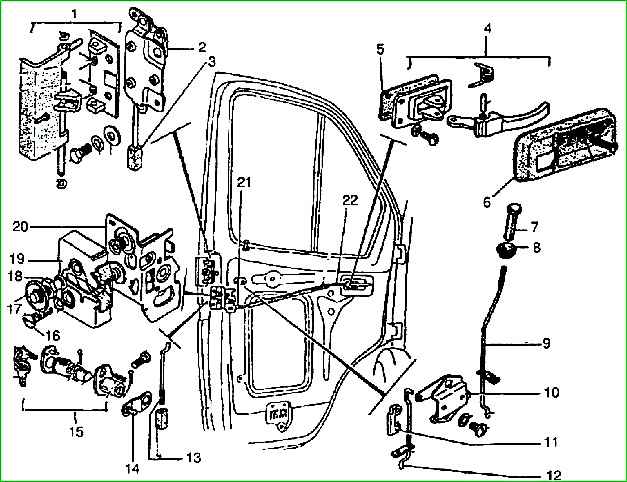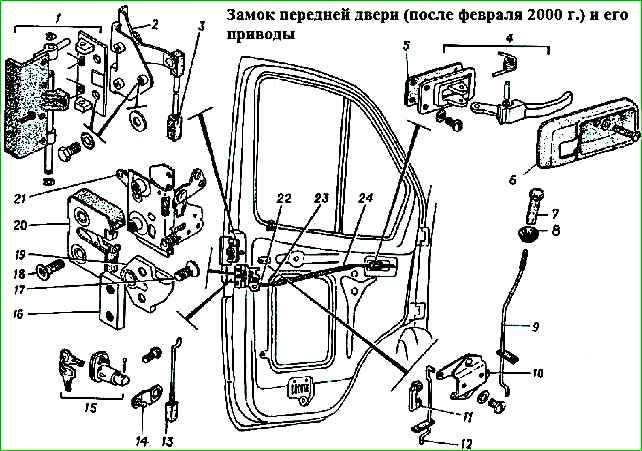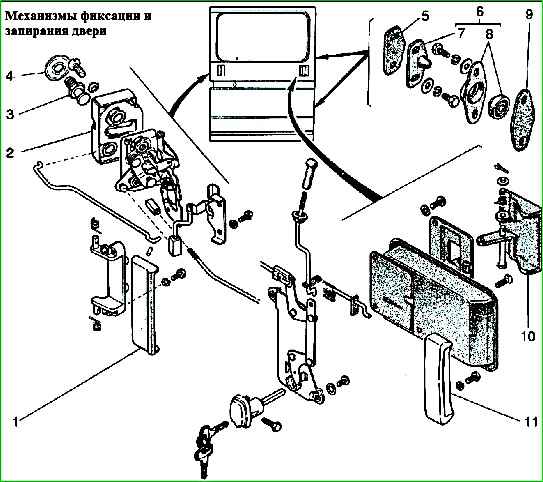Locks are used to hold doors in a closed position while driving, in a parking lot, and in the event of a traffic accident
Door locks - automatic, fork type
Due to the teeth of the rotor and cam, the door is completely closed (on the main tooth) and incompletely closed (on the safety tooth).
When driving with the door not fully closed, a knock occurs; driving with the door uncovered is unacceptable.

Until February 2000, locks were installed on the front doors, the design of which is shown in the figure.
The lock consists of three parts: a locking mechanism 19, a lever mechanism 20 and a latch pin 18.
The lock can be opened from outside and inside the cabin, it can be locked both from outside and inside the cabin when the door is completely closed.
To open the lock from outside the cabin, use the external handle 1 with a drive.
If you grab the outside handle when the lock is unlocked and pull it towards you, the door will open.
When the lock is locked, the outer handle has free movement. To open the lock from inside the cabin, use the internal drive 4.
If you turn (pull) the handle of the internal drive towards you when the lock is unlocked and push the door outward, it will open.
When the lock is locked, the internal drive handle has free movement.
To lock the lock from the outside, use the lock switch 15, and from the inside, use the button 7 to turn off the lock.
You cannot lock the lock when the door is open, neither from outside nor from inside the cabin.
External and internal interlocks are connected to each other, and impact on one type of interlock automatically triggers the other.
Attaching the locking mechanism requires checking its reliability.
If you close a door with a loose locking mechanism, the door cannot be opened either from the outside or from the inside.
To replace the locking mechanism, you need to unscrew two screws, remove the mechanism, replace it with a new one, install it on the door, check the operation of all drives and the correct closing of the door, and, if necessary, check the adjustment of the drives and the latch pin*.
* A latch is installed on the left rear door.
To adjust the spike, you need to loosen it, move it in the desired direction and tighten it.
Replacing the outside handle or lock switch
- - remove the window handle (for front doors);
- - remove internal drive socket 6
- - remove the handrail on the door;
- - remove the door opening limiter and the limiter lever clamp (for the rear door);
- - remove the door trim and anti-noise gasket;
- - unscrew the bolts securing the outer handle and replace the handle;
- - bend the cotter pin securing the switch arm and remove the arm;
- - unscrew the screws securing the internal drive and unscrew the rod 12;
- - unscrew the screws securing the locking mechanism, remove the locking mechanism;
- - move the lever mechanism with the attached parts inside the door towards the installation hatch and disconnect the rod end, remove the internal drive and the lever mechanism with the remaining parts;
- - disconnect the external drive, check its operation; drive parts must move freely, and rubbing surfaces must be lubricated with machine oil;
- - if the lever mechanism is faulty, replace it with a new one.
Assemble and install parts and components in the reverse order, checking individually for the correctness of the adjustments made and the operation of the drives.
The correct operation of the drive is checked with the door open after its installation, for which, using a screwdriver, move the rotor of the locking mechanism from the “open” position to the “closed” position by two teeth (the lock is completely closed), and then turn the corresponding drive - external or internal.
The rotor should move from the “closed” position to the “open” position.
If the spring is weak, this may not happen, then with the drive turned all the way, check the possibility of free movement of the rotor using a screwdriver; touching is not allowed.
If this does not happen, then you need to screw the tip of the external drive or the rod of the internal drive 2 turns and check the operation again.
After receiving a positive result, check the operation of the locking system.
To do this, again, with the door open, move the rotor of the locking mechanism from the “open” to the “closed” position and press the tip of the rod 7 down, after which neither the external nor the internal drive should open the lock.
The lock and its drives do not require special maintenance; when the force increases during operation, the ball The niers must be lubricated with machine oil.
Since February 2000, modified locks have been installed on the front doors with increased reliability (due to increased engagement of the rotor and cam teeth and increased precision in manufacturing parts) and reduced closing noise (due to mass coating of the rotor and cam, retainer and base material of the locking mechanism ).

The locks are manufactured under license from the Brano company (Czech Republic) and consist of a locking mechanism (outer part of the lock) 20, a lever mechanism (inner part of the lock) 21 and a lock retainer 19.
The lock can be opened from outside and inside the cabin, and locked when the door is completely closed from outside and inside the cabin.
If you grab the outside handle when the lock is unlocked and pull it towards you, the door will open.
When the lock is locked, the outer handle has free movement.
If you turn (pull) the handle of the internal drive towards you when the lock is unlocked and push the door outward, the door will open.
When the lock is locked, the internal drive handle has free movement.
To lock the lock from the outside, use the lock switch 15, which locks the lock with keys of the corresponding series, and from the inside - with button 7.
You cannot lock the lock when the door is open, neither from outside nor from inside the cabin.
External and internal interlocks are connected to each other; impact on one type of blocking automatically triggers another.
Changed door locks are not interchangeable with locks of the old design in terms of connecting dimensions and latch design.
To replace the locking mechanism, you need to unscrew two screws, remove the mechanism, install a new one on the door, check the operation of all drives and the correct closing of the door, adjust the drives and lock latch.
To adjust the lock retainer, you need to loosen the screws 17 of the fastening, move it in the desired direction and tighten (the remaining operations for replacing various components are similar to the operations with a lock designed before February 2000).
The locks of the side and right rear doors, their external and internal drives, and the locking system are similar in design to the front door lock systems of the design before February 2000.


Lock malfunctions and troubleshooting
Cause of malfunction - Remedy
The door does not close or closes only after a vigorous push
During installation, the door lock pin is moved inside the cabin - Loosen the pin and move it outward by 1-2 mm
The external or internal lock drive has been adjusted incorrectly - Check separately for the correct adjustment of the external and internal drives
The door is not blocked either from the outside or from the inside of the car
The external or internal drive adjustments have not been made correctly - Make the necessary adjustments separately and check the operation of the locking mechanisms
The door does not close completely (only on the safety tooth)
The locking mechanism buffer interferes with the movement of the lock rotor - Replace the rotor or replace the locking mechanism
Outer door handle does not work
The protrusion of the outer handle is broken - Replace the outer handle.
Drive tip 3 is cracked or broken - Replace tip or drive.
The outside handle does not return to its original position after opening
The drive levers are stuck - Loosen the rivets of the levers, lubricate the drive and check its operation; if the result is bad, replace the drive.
The locking mechanism does not work
It is difficult to move (turn) the rotor and lock cam - Replace the locking mechanism





